 Do you know how your gas furnace works? You probably have a basic idea: gas burners heat the air and this air goes into the ductwork to the rooms. You don’t need to have more complex knowledge than that to enjoy heat from your furnace, especially since you’ll need to have professionals handle any services you need for it.
Do you know how your gas furnace works? You probably have a basic idea: gas burners heat the air and this air goes into the ductwork to the rooms. You don’t need to have more complex knowledge than that to enjoy heat from your furnace, especially since you’ll need to have professionals handle any services you need for it.
But you can benefit from knowing more about the basics of how your furnace works. More knowledge makes it easier to understand when the furnace is malfunctioning and requires service. It can also help you with safe practices.
How much your furnace can heat
First, we’ll talk about heat measurement. The amount of heat a gas furnace can produce is measured as British Thermal Units (BTUs). BTUs are small, so your furnace will need to produce thousands of them to deliver comfort. Determining how many BTUs a furnace must create to properly heat a home is an important step in furnace installation—professionals must “size” the furnace so its BTU output will be powerful enough to heat the entire home to a comfortable level, but not so powerful it will become wasteful.
The heating cycle starts
Your furnace produces BTUs by combusting natural gas. But first it needs to have a signal to start the heating cycle. The signal comes from the thermostat, which connects to the furnace’s control board and temperature control: these are the parts of the furnace that regulate the heat and keep the furnace operating safely. The control board activates several parts to begin the cycle:
- The gas valve that allows natural gas to flow to the burners, located in the burner assembly
- The draft inducer fan, which pulls air through the return vents and into the burner assembly
- The ignition system, which ignites the gas from the burners (in most modern furnaces, this is an electronic system that uses a hot surface to light the burners)
Heating the air
As the gas from the burners combusts, it creates heated air. However, this air cannot come in contact with the air that will enter the ductwork because this will allow dangerous gases into the house. The heated air instead moves through the heat exchanger, a metal container that becomes hot from the combustion gases. The blower fan sends air across and around the heat exchanger, where the air picks up the heat from the walls of the exchanger. This air then continues into the ductwork and to the rooms.
Venting the gas
The combustion process creates gas by-products inside the exchanger, and these gases need to be moved out of the home. When the control board shuts off the burners to end the heating cycle, these gases in the exchanger exit through a flue, a small chimney that exhausts the gases through the roof.
There are some variations on this process depending on the type of furnace. For example, condensing furnaces use two heat exchangers to draw extra heat from the combustion gases. Modulating furnaces can alter how much gas flows to the burners. If you have any questions about these furnaces or about any part of your furnace in Monument, CO, feel free to ask our team!
Robbins Heating & Air Conditioning serves Colorado Springs and the surrounding area. Call us for gas furnace services.
